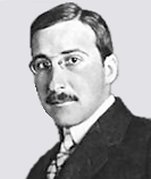|
被禁止的性行为与性暴力
|
|
卖淫: 历史记载
3
|
|
 |
|
斯蒂芬·茨威格
(1881-1942),卓越作家,当纳粹德国兼并他的祖国奥地利时,他流亡于国外。他的很畅销的著作,像其他犹太作家的作品一样曾经被查禁。他设法完成了回忆录并迁居巴西,却终因绝望而自杀。他的回忆录于其逝世后得以出版。
|
|
Stefan Zweig
(1881-1942), a brilliant writer, had to flee into exile when Nazi Germany annexed his native Austria. His very popular books, like those of all other Jewish authors, were banned. He managed to complete his memoirs and move to Brazil, but eventually was overcome with despair and committed suicide. The work was published posthumously. |
|
|
许多现在哀叹存在着卖淫的人们并不知道——或者已经遗忘了,在“美好的往昔”,卖淫更为广泛地存在着。甚至直到20世纪早期为止,不但上海一些声名狼藉的街区及其它的亚洲城市,而且在欧洲与美国的大城市也有比现在多得多的大量的妓女存在。正如斯蒂芬·茨威格(Stefan Zweig)就他在帝制的维也纳成长的回忆录里曾经写到的那样:
|
“当今一代人对大战之前在欧洲波及范围之广的卖淫业几乎没有任何的概念了……。在那个年代,城市里的人行道站满了如此多忙于待价而沽的女人,以至于要避开她们比要找到她们还要难上加难。另外,那时,有着数也数不清的“紧闭门户的房屋”、夜总会、有着歌舞表演的酒店与充斥着舞女的舞厅以及酒吧间。女性作为商品曾经时时刻刻在任何地方以任何价格公开待价而沽,并且男人购买一个女人半小时、一小时或一整夜比买一盒香烟或一张报纸还要来得方便。[斯蒂芬·茨威格.昨日的世界(Die Welt von Gestern),1944]。
|
|
正如茨威格本人已经记载的那样,第一次世界大战之后,局面开始大为改观,当女人(替代第一次世界大战中已经战死的男人)逐渐进入正规劳动大军和当崭新的性自由观念让年轻人有更多的机会相识和公开交往之时,卖淫的境况才开始发生改变。继而,这又让年轻男人更容易放弃去找妓女的念头。当然,紧随第一次世界大战之后的数年里,全面的经济萧条起先曾经导致卖淫的增加,不过,随着妇女开始获得解放[1],一种趋势就已经在酝酿之中,那就是逐渐减弱了妇女的依附性[2],而且这种趋势也持续至今。不过,重新出现的经济低迷则属例外。例如,美国1930年代的大萧条时期,或第二次世界大战后西欧的贫困时期,或者现在正加入富裕的西方阵营[3]的不发达的东欧国家。无论如何,欧洲和美国除了这些挫折时期或其中不发达地区以外,卖淫在那里再也从未达到从前的那种规模。
[1]. 这里指妇女前所未有的就业——译者注。
[2].
指经济上依附男人的状态(见前述的关于女人对男人的依附是卖淫的关键问题)。另见威廉·冯·洪堡(Wilhelm
von Humboldt)1926/27年拟定了性学研究的主题大纲《人类依附史》(History
of Dependency in the Human Race)。——译者注。
[3].
作者意指加入欧共体。——译者注。
|
|
Prohibited Sexual Behavior and Sexual Violence |
|
Prostitution: Historical Note 3 |
|
Many people who now bemoan the existence of prostitution do not know – or have forgotten – that it was much more extensive in the “good old days”. Indeed, until early in the 20th century, not only certain infamous sections of Shanghai and other Asian cities, but also the large cities in Europe and the USA had a great many more prostitutes than they have today. As
Stefan Zweig wrote in his memoirs about growing up in imperial Vienna: |
|
“The present generation has hardly an idea of the enormous extent of prostitution in Europe before the World War…. In those days the sidewalks were so busy with women for sale that it was harder to avoid them than to find them. In addition, there were the numerous “closed houses”, the nightclubs, the cabarets and dance floors with their dancing and singing girls, the bars with their hostesses. The female merchandise was openly offered at every hour and at every price, and a man had no more trouble buying a woman for a quarter hour, an hour, or a night than buying a pack of cigarettes or a newspaper.” (Stefan Zweig, Die Welt von Gestern (The World of Yesterday) 1944.
|
|
As Zweig himself
already noted, the picture began to
change after WW I when women
increasingly entered the regular
workforce (replacing men who had died in
the war) and when a new sexual freedom
offered young people more opportunities
to meet and to interact openly. This, in
turn, made it easier for young men to
give up visiting prostitutes. Of course,
in the years immediately following the
war, the general economic misery at
first brought an increase in
prostitution, but with the beginning
emancipation of women a trend had been
set in motion that gradually reduced
their dependency, and this trend has
continued to this day. The exceptions
have always been tied to new economic
downturns, for example the Great
Depression of the 1930s in the US, or
the poverty of Western Europe after WW
II, or that of the underdeveloped East
European countries now joining the
richer West. In spite of these setbacks,
however, prostitution in Europe and the
US has never reached its former extent
again. |